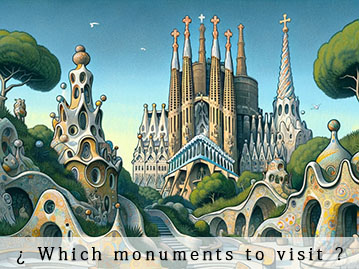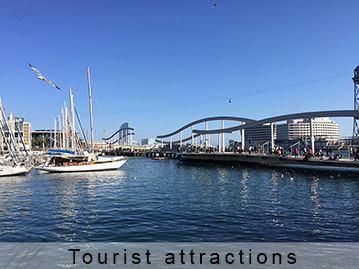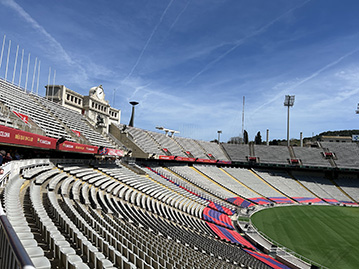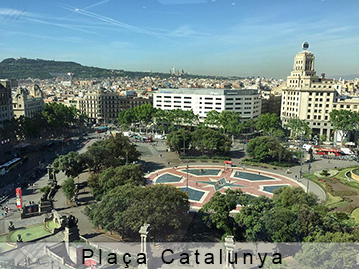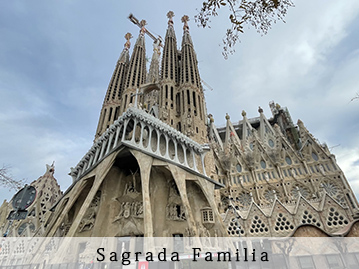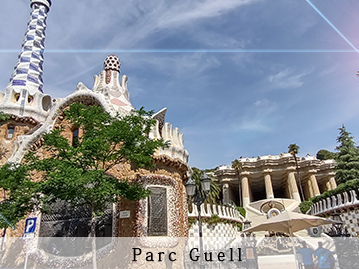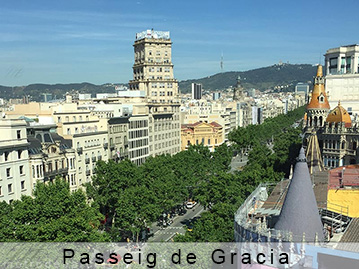As every year, as summer comes around, the Barcelona metro announces plans to renovate and improve some sections, and advises of the partial or complete closure of some of its lines, and the introduction of substitution buses; this year, lines L4 and L11 will be affected by the works.
For the third consecutive year, the yellow line (L4) which runs from Trinitat Nova to La Pau will close part of its route.
From 25 June to 31 August, the section from Verdaguer station to Trinita Nova will be completely out of service.
For its part, the L11 line, which shares tracks with line 4, will close the section between Trinitat Nova station and the Casa de l'Aigua stop.
The return to normal on L4 and L11 metro lines is planned in 2 stages : on the one hand, from 1 September, the part of the L4 line that runs from Verdaguer to Maragall will return to service; on the other hand, the last 4 stations of the L4 line, as well as the L11 line, will resume service from 7 September.

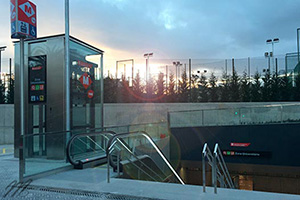
Barcelona metro
Barcelona how to get around by metro
From subscriptions, cards and Barcelona metro fares to the opening and closing hours, from Barcelona jpg or pdf metro map with tourist attractions to each lines, stations and transfers to the city's main public transport network, find informations on our Barcelona metro guide and start to plan your routes from barcelona best tourist attractions to places and monuments, by metro. With the metro of Barcelona, make your visit easier.
Ticket prices
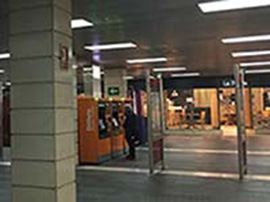
From Barcelona metro ticket valid only for an individual journey to the card valid during 1 to 5 days, from a monthly to a three-monthly card, from zone 1 to zone 6, to individual and many people tickets, discover how to plan all your itineraries according to the length of your stay in Barcelona, the catalonia's capital.
Among Barcelona metro tickets
T-casual : Metro card of 10 trips in Barcelona's transport system ;T-familiar : 1 return trip for 4 people, Great for Family Travel ;
T-Grup : Discover Barcelona as a group, 70 journeys to share ;
T-usual : Subway card valid for 30 days for personal use ;
T-Dia : Visit of Barcelona in 1 day, 24 hours of unlimited transportation ;
Hola : Itinerary from 2 to 5 days to discover Barcelona by metro ;
Single ticket : Barcelona bus or metro single trip.
HOLA METRO CARDS
Unlimited access to public transport in Barcelona from 2 to 5 days
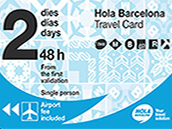
Barcelona Hola metro pass 2 days
The Hola Barcelona 2 days gives unlimited access to the metro, bus (tmb), tram, Montjuic funicular and FGC and Rodalies trains (zone 1), for 48 hours. Purchase it now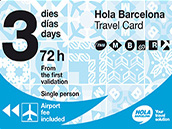
Barcelona Hola metro pass 3 days
Same concept as the Hola 2-days card, the Hola 3-days metro card gives access to the same transport as well as to T1 and T2 terminals. Book your pass online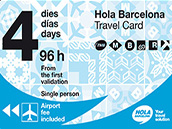
Barcelona Hola metro pass 4 days
Unlimited access to metro, bus (tmb), tram, Montjuic funicular and FGC and Rodalies trains (zone 1), for 4 consecutive days. Get your 4 days travel pass now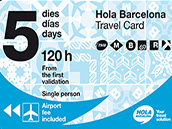
Barcelona Hola metro pass 5 days
This card offers the same benefits as the other Hola Barcelona cards for 5 days from validation even after arrival at the airport. Reserve your transport now
Among the different tickets and prices of the Barcelona metro, we have one-person cards that cannot be used by 2 travellers, integrated fares that give access to different public transport services in Barcelona with the same ticket, as well as integrated collective tickets that can be shared by several people.
Hola subscriptions or the Dia card are part of the integrated rates for personal use, T-familiar and T-grup tickets are also integrated but can be used by several people.
To increase the use of public transport and reduce the use of the car in the Catalan capital, The Generalitat announced on Friday 12 November that the prices of the Barcelona metro will be, for the second consecutive year, the same as the previous year and will not be increased in 2022.
Metro Hours
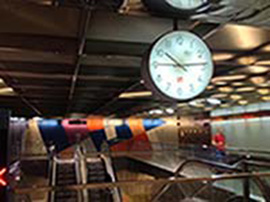
From monday to thursday , Sundays and festive days, the metro of Barcelona runs from 5am to midnight.
Fridays and festive days before the metro of Barcelona runs from 5am to 2am.
Saturdays, the metro runs all day long.
Metro map
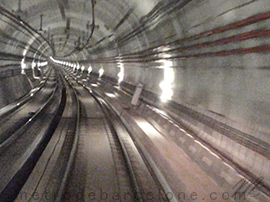
Iphone, Ipad, PC, and tablets, our Barcelona metro map in PDF or JPG format adapts to all types of media to guide you from line to line in your Barcelona itinerary.
Thanks to our map of the metro of Barcelona, among more than 151 stations and 50 connections (including 2 stops for Barcelona airport) who share the colors of the 12 metro lines of Barcelona that are divided between the TMB and the FGC, locate the tourist attractions and monuments to visit and find out more information about the station you wish to reach.
Barcelona metro map with monuments JPG
Barcelona metro map with monuments PDF
Metro lines
Composed of colours and numbers, the whole of the lines from 1 to 5, and 9 to 11 which constitute the Barcelona and its nearby municipalities such as Cornella, Badalona or L'Hospitalet de Llobregat metro network system, and stretch hundreds of kilometers , are handled by TMB company (Transports Metropolitans de Barcelona).
Lines 6, 7, 8 and 12 belong to FGC (Ferrocarrils de la Generalitat de Catalunya) run through Barcelona and its neighbouring towns such as L'Hospitalet de Llobregat, Cornella de Llobregat, and Sant Boi.
From Plaça Espanya (L8), Catalunya (L6 and L7), and Sarrià (L12), this lines are in connection with the lines 1, 3, 5 and 9 of the metro of Barcelona.
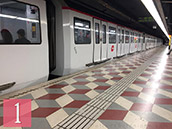
Barcelona metro line 1
The Barcelona metro line 1 extends of Hospitalet de Bellvitge until Fondo on a total of 30 stations among which 15 links towards other lines allows the access to numerous Barcelona inescapable such as las Ramblas.
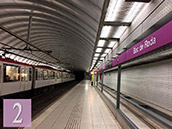
Barcelona metro line 2
The Barcelona metro line 2 extends of Paral-lel until Badalona with a total of 18 stations among which 8 links towards other lines allows the access to numerous of inescapable of Barcelona such as Barcelona's bullrings.
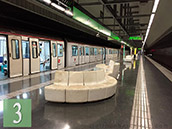
Barcelona metro line 3
With 26 stops among which 16 correspondences from Zona Universitaria station to Trinitat Nova, the Barcelona metro line 3 guides you at the foot of the most beautiful places and parks such as the park Guell.
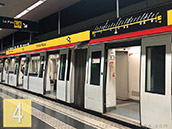
Barcelona metro line 4
The line 4 (yellow) of the subway of Barcelona wich along Beaches and cross the Gothic district, passes through 22 stations among which 8 links. It gives access to great monuments and places such as the Cathedral.
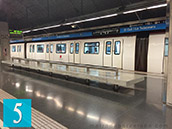
Barcelona metro line 5
From Cornella Centre station to Vall d'Hebron, the line 5 of the metro of Barcelona consists of 27 stations and 13 correspondences. The line 5 also leads to the feet of the Sagrada Familia , the Paseo de Gracia and Diagonal.
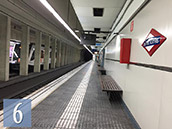
Barcelona metro line 6
From Plaça Catalunya to Sarrià, the Barcelona underground line 6 consists of 8 stations which, among the Barcelona best places, give access to Plaça Catalunya, the Rambla and the district of Gracià.
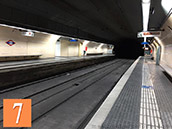
Barcelona metro line 7
From Plaça Catalunya too, the line 7 which consists of 7 stations to Avinguda Tibidabo gets to the foot of the Ramblas of Barcelona, Gracià district, and brings you closer to the Barcelona amusement park Tibidabo.
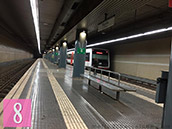
Barcelona metro line 8
From Barcelona Plaça Espanya to Moli Nou - Ciutat Cooperativa, the line 8 gives access, among the great monuments and places of Barcelona, to Montjuic district and the Espanyole stadium.
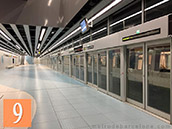
Barcelona metro line 9
The line 9 that extends from La Sagrera to Can Zam for the northern part and from Zona Universitaria to Aeroport T1 for the southern part is the Barcelona metro line wich lead to Barcelona airport T1 and T2.
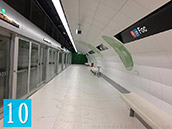
Barcelona metro line 10
From La Sagrera station to Gorg station, the line 10 of the Barcelona metro has only 6 stations and shares part of its route with line 9.
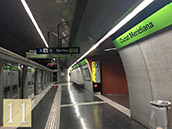
Barcelona metro line 11
The Barcelona metro line 11 travels from Trinitat Nova station to Can Cuiàs and has links with lines 3 and 4. The line 11 has only 5 stations.
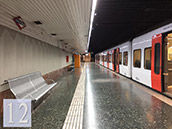
Barcelona metro line 12
From Plaça Catalunya to Sarrià, the Barcelona metro line 6 consists of 8 stations which, among the Barcelona best places, give access to Plaça Catalunya, the Ramblas and the district of Gracià.
Barcelona Hola pass
Barcelona unlimited public transport cards
From 2 to 5 days, the Hola card is the best option to visit Barcelona without stress, with unlimited access to public transport. From metro to tram, bus (TMB) or Montjuic funicular, not forgetting zone 1 trains, the Hola Barcelona card also includes transport between airport and Barcelona city centre.
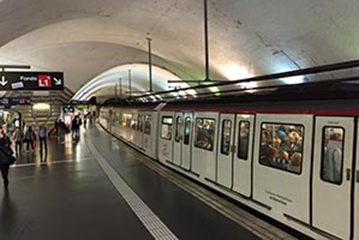
Barcelona metro stations list
Barcelona Metro stations from A to Z
If you already know the name of the metro station you have to go to, if you have more or less an idea of its name, check the list of Barcelona metro stations in alphabetical order.
By clicking on the stop of your destination, you will not only be able to find out which metro lines lead to it as well as the connections available between metro, tramway, funicular or cable car, but also what you can discover there, such as monuments, museums, restaurants or tourist sites.
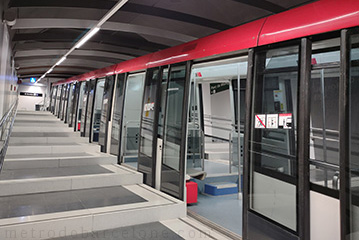
Barcelona metro FAQ
Questions most asked on Barcelona metro
Rates, location, schedules, how and where to go, to help you and answer your questions as quickly as possible, we share the most frequently asked questions on our information forum about the Barcelona metro.
What is the price of the subway ticket for a child, how the 10-trip card works, does the Hola card work from the airport ; if the answer to your search is not there, send us your request by email to info@metrodebarcelone.com.
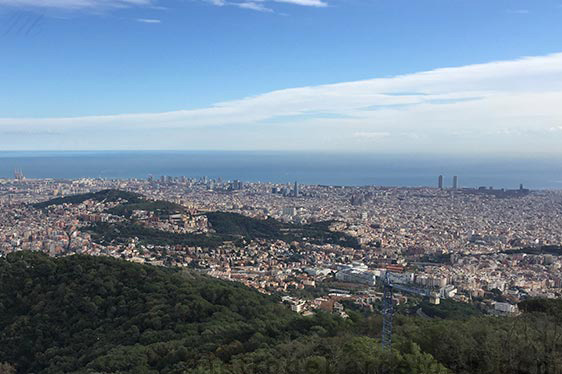
Barcelona guide + metro
Which Barcelona metro stations to get off at
With more than 2000 years of history distribuated in 101 km2 of avenues, allays, places, and parks, the capital of Catalonia contains treasures of exceptional architectures. Middle age, the renassance, and modernism, who can't be unnoticed between the sea and mountains of Barcelona.
With the metro of Barcelona, go to discover the kingdom of the most popular architect in the history of Spain, Antoni Gaudí, among some of which monuments of Barcelona such as the Sagrada Familia, the Casa Batlló, the Palau Guell, the Pedrera and the park Güell, are classified world heritage of the humanity by the UNESCO.
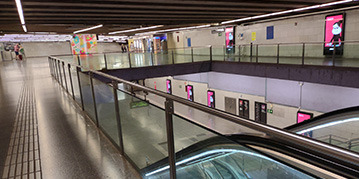
Metro in Barcelona
In use since December 1924, Barcelona's metro network which once stretched between the Catalonia square and the Lesseps station has well evolved. Nowadays, the 12 metro lines of Barcelona, managed respectively by the TMB (Transports Metropolitans de Barcelona) for lines 1 to 5 and 9 to 11, and the FGC (Ferrocarrils de la Generalitat de Catalunya) for lines 6 to 8 and 12, and extending over 165 kilometers through 190 stations, place the Barcelona metro in second place as the largest metro in Spain behind Madrid.
Winter or summer, the 12 different colored lines are equipped with air conditioning in order to make any trip to the Catalan capital much more pleasant. Thanks to its wide choice of transport tickets, there are many possibilities to visit Barcelona by metro, on very variable packages from 1 to 5 days, monthly or quarterly.
Travelers who wish to combine bikes + metro can board with a bicycle during off-peak hours, in contrast to the Ferrocarrils and the tramway, which do not have a fixed schedule ; they can also take the subway with their dog in wearing a muzzle, also outside the peak hours.
Apart from a handful of stations, the Barcelona metro is very well equipped for people with reduced mobility.

Barcelona metro links
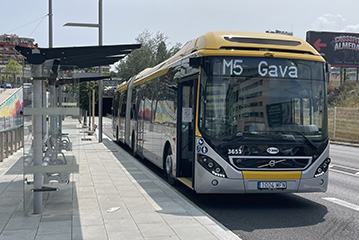
Metrobus M5
Bus line from Cornella to Castelldefels
From Cornella de Llobregat to Castelldefels, through Sant Boi de Llobregat, Viladecans, and Gavà, the M5 metro bus line connects these municipalities of the Baix Llobregat with a bus every 10 minutes on weekdays; on Saturdays, public holidays and working days in August, the frequency between 2 buses increases to 15 minutes. Connected to the Barcelona metro (line L5) as well as to the R1 and R4 train lines at the Cornella stop, the link between the different stops covered by the M5 "metrobus" facilitates access to some of Barcelona's tourist sites, such as Camp Nou, from Castelldefels or Gava.
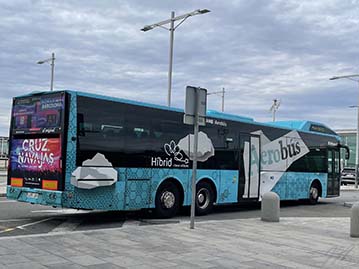
Aerobus
Transfer between airport and Barcelona city centre
To travel from one of the Barcelona airport terminals to the city centre, and vice versa, the aerobus provides a shuttle service available all year round that makes a circuit through some strategic points of the Catalan capital such as Plaça Catalunya or Plaça Espanya, and at the same time allows connections to Barcelona's metro lines such as the L1, L2, L3, L6, L7, or L9.
-
Plaza Cataluña Plaza España Gran via Urgell Plaza Universidad
Barcelona airport shuttle tickets
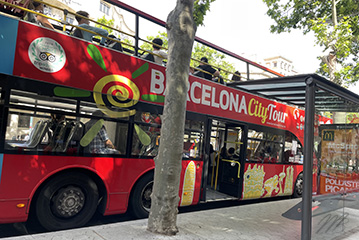
Barcelona Tourist Bus
Discover Barcelona's most important sights by bus
Comfortably seated in an open-top bus, with an audio guide available in more than ten languages and a map of the city, the Barcelona tourist buses will take you to the most important tourist sites of Barcelona among the 40 stops of the different itineraries suggested. Accessible from many Barcelona metro stops, the tourist bus is one of the city's transport options that allows you to visit a large number of squares, parks and monuments in Barcelona that you should not miss without having to move.
Barcelona turistic bus tickets
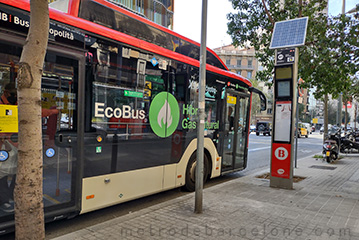
Expres bus
Connecting the 2 networks of the Barcelona Tram
The first Espress bus line "XPRESBus X1" which runs between Plaça Francesc Macià and Plaça de las Glòries, through the city centre, connects the lines from T1 to T3 with the lines from T4 to T6.
With links to metro lines L1, L2, L3, L4 and L5, the Express X1 bus line provides access to, among others, the Ramblas and Plaça Catalunya via by Pl Universitat station, at the Passeig de Gracia and the beautiful Casa Batllo by Gran Via station - Pau Caris, as well as the Barcelona flea market and the Las Glories shopping centre through Mercat dels Encants station.
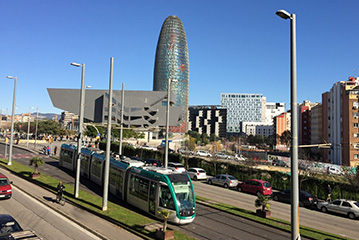
Barcelona tramway
Link between tram and metro in Barcelona
Including the blue tram line that runs between the Avinguda Tibidabo metro stop and the funicular that climbs to the foot of the Barcelona theme park, the Tibidabo, Barcelona's tram network consists of 7 lines. Lines 1 to 3 serve the southern part of the city and its surrounding towns ; lines 4 to 6 connect the northern part of Barcelona and its suburbs. The link between tram and metro allows easier access to some places not served by the Barcelona metro such as the Auditori or the Forum Port of Barcelona. Each of the lines from 1 to 6 is connected to at least 2 lines of the Barcelona metro.

Barcelona Montjuic funicular
Link between metro and cable car of Montjuic
Accessible by lines L2 and L3 (Barcelona metro green line), the funicular is the fastest way to get halfway up Montjuic hill which contains a large part of parks, monuments and tourist attractions of Barcelona.
From Paral-lel metro station, with your metro ticket, the funicular takes you in no time to the foot of the cable car that leads to the top of Montjuic, a few steps from the Joan Miro Foundation, in the heart of one of the city's must-see parks.
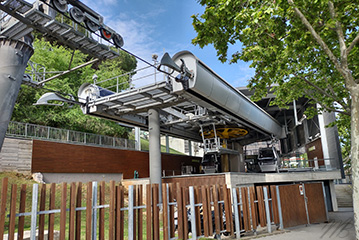
Barcelona cable car
Visit Barcelona from the sky
From the top of Montjuic hill to the beaches of Barcelona, through the old port of the city, Barcelona's cable car runs back and forth between Montjuic Castle and the sand of Barceloneta on a set of four stops that give, among other things, access to the Port Vell, at the Ramblas, the beachfront or the Joan Miro Foundation. The cable car can be reached by the Barcelona metro via line 4 by getting off at Barceloneta station, the line 3 by getting off at the Drassanes metro stop, or lines 2 and 3 from the Paral-lel metro station where the funicular leads to the foot of the cable car halfway up Montjuic hill.
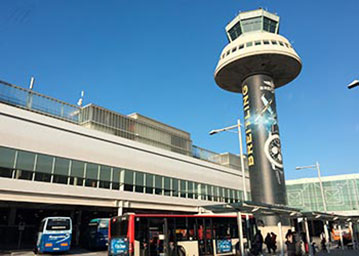
Barcelona airport
How to get from Barcelona airport to the city centre
Among the different public transportation options available upon arrival at Barcelona el Prat airport,, whatever your terminal (Terminal 1 or Terminal 2), the Aeroport T1 and Aeroport T2 stations on metro line 9 provide easy access to Barcelona from the airport.
With Barcelona's metro line 9 you are only a few minutes away from the main tourist attractions of the Catalan capital such as the Plaça Catalunya, the Gothic Quarter or the Ramblas by taking the connection with line 1 (red line) at Torrassa station ; or the old port, the Gracia district or the Guell park via the Zona Universitariala station on line 3 (green).
The Barcelona metro ticket price to get to Barcelona from airport T1 and T2 is 5.50 €. (2024 metro fares).
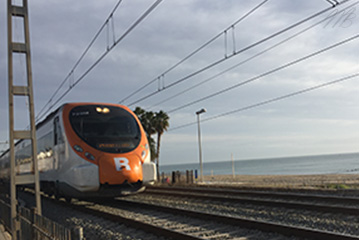
Barcelona Trains
Between trains and the Barcelona metro
Your train has just arrived on one of the platforms at Sants station ; You are in the middle of Barcelona.
To start your visit to Barcelona by metro from Sants station, you can choose between line 3, which takes you to many sites to visit such as the Port Vell, the Ramblas, the Gothic Quarter or the Guell Park, and line 5, which takes you directly to the foot of the Sagrada Familia and the Camp Nou among others.
If you arrive in Barcelona from the Estación de Francia, the nearest metro station is Barceloneta on line 4 (yellow line) ; From this station you can go to the Barceloneta district and the old port of the city (Port Vell).
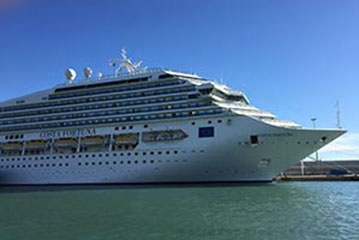
Barcelona cruise port
Reaching the metro from your stopover in the port of Barcelona
You're welcome in the cruise port of Barcelona, and whatever your call in the capital of Catalonia takes, find out how make the most of your visit of Barcelona locating in first your access point to the city as well as the monuments of Barcelona, and their metro station, the nearest of your anchor point at port of Barcelona.
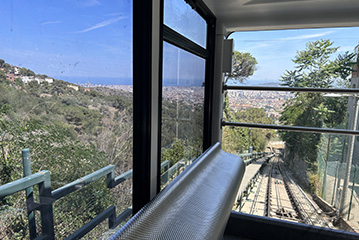
Barcelona Vallvidrera funicular
Reach Barcelona's peaks by Vallvidrera funicular railway
The Vallvidrera funicular, which runs from the lower to the upper part of the Sarrià district, climbs to the top of the Vallvidrera neighbourhood without stopovers.
Accessible via Ferrocarriles de la Generalitat (FGC) lines S1 and S2 at Peu del Funicular station, from Plaça Catalunya, the Vallvidrera funicular takes you to the foot of an exceptional landscape that brings you close to some of Barcelona's must-see sites, such as the Tibidabo theme park, the Collserola tower and the Expiatory Temple of the Sacred Heart (Sagrat Cor) of Tibidabo.
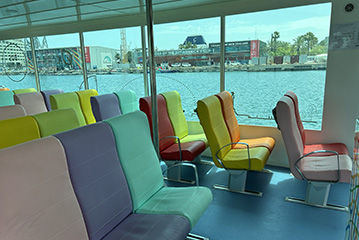
Barcelona Nautical Bus
How to get to Barcelona's beaches from the port
In service since July 2024, the "Nautic Bus" is the fastest and most environmentally friendly way of getting back and forth between the Drassanes quay on the one hand, which hosts many of Barcelona's sights and monuments, such as the Columbus Column, the Ramblas, the Gothic Quarter or the Maritime Museum, and the Llevant quay on the other side which leads to the foot of the Barceloneta beaches and its animation. Tourist attraction and transport at the same time, only a few metres from Barcelona Drassanes metro station, the bus boat "Bus Nautic" offers short sea trips for less than 2 euros.
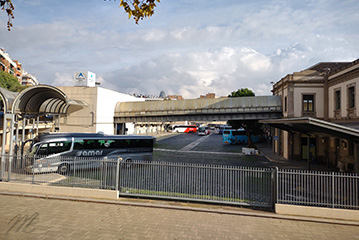
Barcelona Nord bus station
Barcelona Estació del Nord Bus station
Located near the Estació del Nord park, just a stone's throw from the Arc de Triomf in the Eixample district, and just over a kilometre from Plaça Catalunya, the Barcelona North Station, officially known as "Estació del Nord" (North station), is a former railway station that has been converted into a bus station and sports complex.
Departure point for many long-distance buses to other Spanish and European cities, la Estació del Nord serves not only national but also international destinations ; It can be reached by the Barcelona Arc de Triomf metro line 1 station.
Essentials pass
How to visit the essentials of Barcelona
The "Barcelona Essentials pass" offer which not only includes fast-track entry to the Sagrada Familia and its interior museum, but also ticket-free access to the monumental area of Parc Guell, as well as unlimited access for 2 to 5 days to Barcelona's public transport network (metro, tram, bus, Montjuic funicular, etc...).
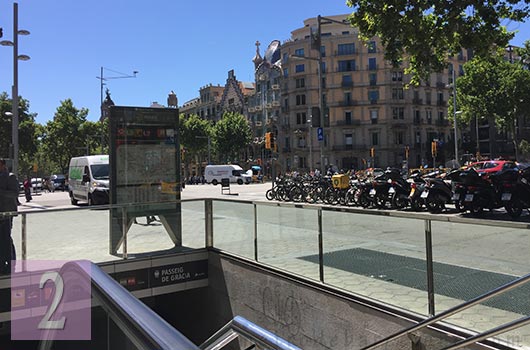
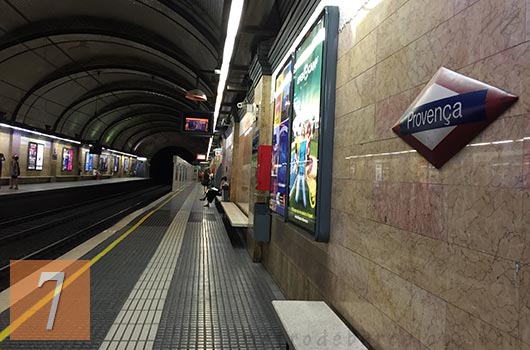
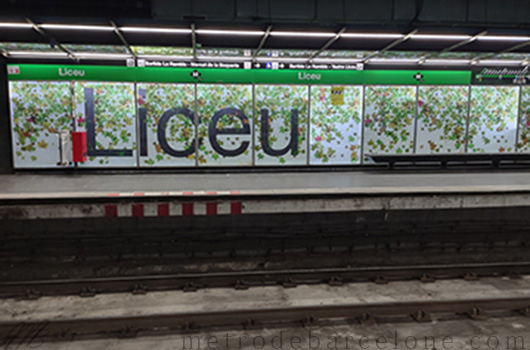
Why Barcelona's metro ?
A number of answers could be given to the question "Why use the Barcelona metro ? ;
such as : the Barcelona metro is pleasant and air-conditioned, the lines run every day, we can move easily and quickly from one point to another, day or night, or say that the metro in Barcelona is clean.
But there are three important points to consider to understand why it is better to visit Barcelona by public transport.
- First of all, note that not all car models can circulate in Barcelona 7 days a week.
In fact, Barcelona City Hall, as well as 200 other municipalities in Europe, do not authorise access to polluting vehicles in the ZBE zone (Low Emission Zone), and this with the aim of ensuring good air quality and combating climate change.
However, Barcelona remains accessible every day of the week from 8 p.m. to 7 a.m. , as well as weekends and public holidays.
For more information about how to get to Barcelona by car at any time of the week, go to the page "VehiclesEstrangers" of ambmobilitat.cat website.
- On the other hand, it's good to know that if your car complies with traffic conditions in the Catalan capital, you will have to find a place to park for each of your visits.
Note that the city of Barcelona has many pedestrian streets, which limits the number of places where you can stop ; in addition, among the parking spaces you will find, blue or green, you'll need to calculate your journey time carefully to avoid a fine.
Please note that payment for blue seats is for a maximum of 4 hours, and that the green spaces that were designed for the residents of the neighbourhood, but which may also be parked, the price is more expensive than the blue seats and can be credited for a maximum of 2 hours.
- And for additional information, an essential advantage of using the Barcelona metro and other public transport services in the city, is that they can drop you off right at the tourist attractions and monuments that you want to see.
The Sagrada Familia metro station takes you right up to the monument ;
Barcelona metro - Terms of use
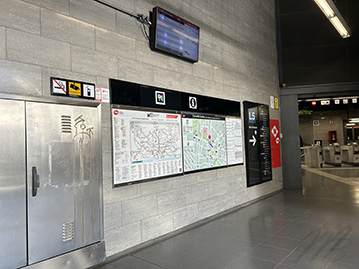
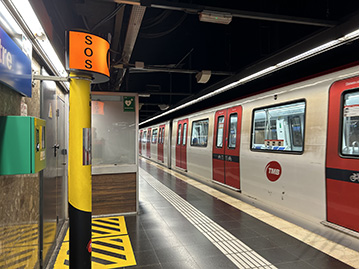
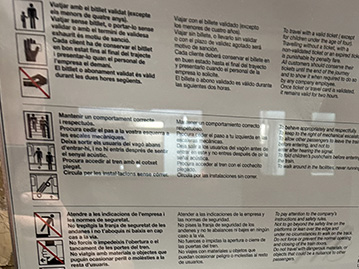
List of conditions for using the Barcelona metro, displayed at each station in order to make using public transport as pleasant as possible, as well as for the traveller, the company that provides the service and all passengers.
What about the obligations of the company that manages the metro in Barcelona, it has, on the one hand, to inform passengers about how the service functions, its impact, as well as the different ticket categories and their prices.
On the other hand, metro staff must treat passengers courteously and assist them in their requests for assistance and information by using interphones.
- people with reduced mobility have the right to use priority seats; this group also has priority in the use of lifts.
- In the event of an incident, the customer may decide not to continue his journey and request an equivalent ticket in exchange.
- If the customer wishes to make a complaint using the forms provided for this purpose and available in every metro station, the company will follow up the complaint to ensure that the user receives a reply.
As regards the customers's obligations, they will have to travel with a valid ticket (except for children under the age of 4).
Any passenger in possession of an unvalidated ticket, a expired ticket or no ticket will be subject to a sanction. Metro tickets must be kept until exit and presented to the staff in the event of an inspection.
Passengers should maintain a correct and respectful attitude by letting people pass on their left on the escalators,
by facilitating the exit of other passengers before boarding the carriage and before the departure signal, or trying to access to the train with the pushchair folded up, for example ; they must also move around the facilities without running.
In terms of safety, it is essential to follow the company's instructions and rules, such as not bending over or getting down on the tracks under any circumstances, do not force or obstruct the opening or closing of the metro doors, or do not travel with materials or objects that may constitute a danger or a nuisance for other passengers.
In the metro of Barcelona, it is also forbidden to smoke, to press the stop or alarm buttons without a valid reason, to distribute advertising or sell without authorisation, or to carry out activities that are inconvenient or dangerous for other users.
About what is allowed, dog owners may travel with their pet under the condition that it is kept on a non-extendable lead less than 50 centimetres long.
If you're travelling by bike, you have the option of taking it with you, on condition that you use the signposted entrances and not the escalators on one side, not to disturb the passage of other travellers in the metro stations and on board the train on the other side, but also to stand in the places reserved for this purpose and not to cycle inside the metro.
Barcelona itinerary
Barcelona tourist itinerary by metro
The number of tourist sites and monuments to visit in Barcelona cannot be counted on the fingers of one hand ; it is thus complicated to make the tour of all the inescapable places of Barcelona with a rather restricted timing. Anyway, with the right information that will help you move from one visit to another, start planning your itinerary according to the time you will spend in the Catalan capital.
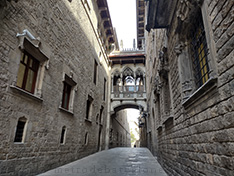
Barcelona 1 day trip
The visit of the most beautiful sites and monuments of Barcelona in 1 day is complicated unless you dedicate about 15 minutes per stage ; discover our suggestion to go through the essential of Barcelona in a limited time.
Barcelona one day trip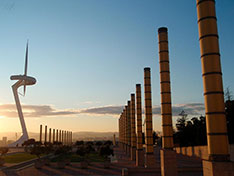
Barcelona itinerary 2 days
48 hours in Barcelona, either the time of a weekend, Allow you to discover a large number of parks or monuments according to your itinerary ; Follow our Barcelona itinerary from one metro station to the next to see the city's must-see sites.
Visit of Barcelona in 2 days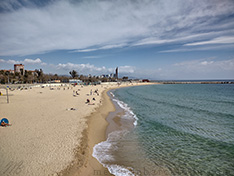
Tour of Barcelona in 3 days
Monuments, museums and tourist sites, in three days in Barcelona you will have time to enjoy your stay more and discover more quietly each of your visits among some ideas of itineraries from one station to another of the Barcelona metro.
Visite of Barcelona in 3 daysBarcelona, what to do ?
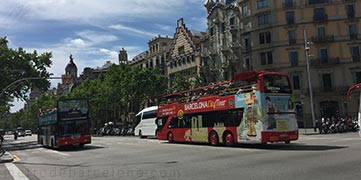
Barcelona Tourist Bus
On its various routes, the tourist bus and its audio guide in ten languages is an excellent way to discover Barcelona.
Metro Plaça Catalunya / L1 / L3 / L6 / L7
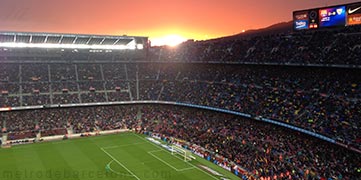
FC Barcelona Stadium
With more than 99,000 seats, the Camp Nou stadium is one of the largest in Europe. Come and discover the Barça atmosphere.
Collblanc metro stop / Line L5 - L9
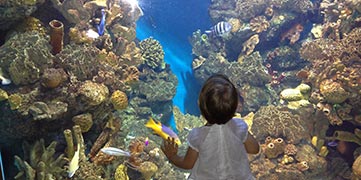
Barcelona Aquarium
The hundreds of species that share the Barcelona aquarium will lead you into the depths of a world as magical as it is mysterious.
Drassanes Line 3 metro stop

Passeig de Gracia
Bordered by luxury shops, restaurants, monuments and exceptional architecture, the Passeig de Gracia connects Plaça Catalunya and the Gracia district.
Passeig de Gracia / Line L2 - L3 - L4
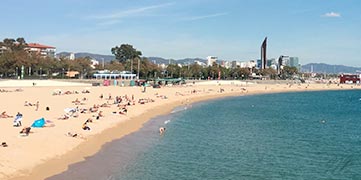
Barcelona beaches
Bogatell, Barceloneta, Nova Icària, or Sant Sebastià, kilometres of sand where restaurants, bars, and entertainment lead the atmosphere day and night.
Ciutadella Vila Olimpica line 4 stop
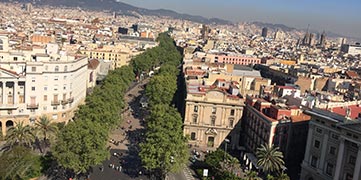 Ramblas of Barcelona
Ramblas of Barcelona
A meeting point between Plaça Catalunya and Port Vell, where artists, painters, restaurants and musicians share the 2 km of the city's busiest pedestrian avenues.
Barcelona L3 Liceu metro stop
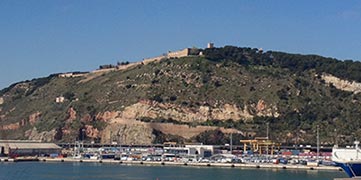
Barcelona Montjuic Hill
Montjuic Hill, where the remains of the Olympic Games, parks and museums offer exceptional views of the city, is one of the most visited tourist sites in Barcelona.
Metro Espanya / Line L1 L3 L8
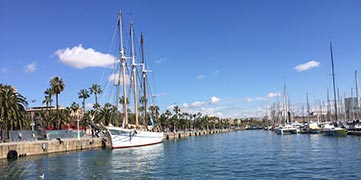
barcelona's old harbour
Bordered by a very pleasant promenade, the Port Vell (Barcelona's old harbour) is located at one end of the Ramblas, stretching from the Plaza Colon to the Barceloneta district.
Drassanes station Line L3
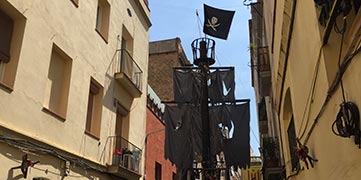
Gracia district festival
Every summer, during the Gracia festivities, some of the streets of the neighbourhood are disguised to give way to the creative imagination of the inhabitants.
Barcelona Fontana metro stop (L3)
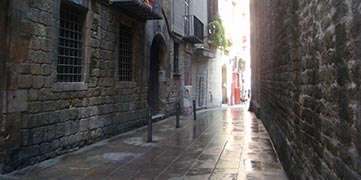
Barcelona's Gothic Quarter
A maze of narrow streets located between the Raval and Born districts, where museums, churches and Roman vestiges trace the history of Barcelona's oldest district, which stretches from the old port to Plaça Catalunya.
Barcelona Urquinaona metro stop
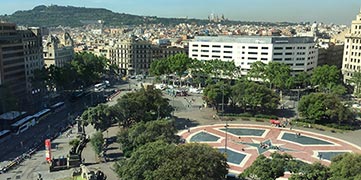
Barcelona Plaça Catalunya
The Plaça Catalunya is the most famous and busiest square in Barcelona, intersecting with some of the most beautiful and popular avenues of the city, such as the Ramblas and the Rambla Catalunya.
Barcelona Plaça Catalunya metro stop
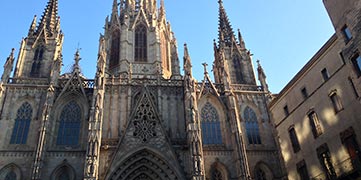
Barcelona Cathedral
Declared as historical monument since 1929, the cathedral basilica of the Holy Cross and Saint Eulalia, in Gothic style, is permanently inhabited by 13 geese that protect the cloister.
Barcelona Jaume 1 line L4 stop
Barcelona metro - read more
By combining the increase of 3% on the prices of transport tickets on the one hand and a continuation of the 50% discount on T-Jove and T-Usual cards, Barcelona metro ticket prices will rise slightly from 15 January 2025.
with the exception of trimestire cards, such as the T-jove (transport card for under-30s with an unlimited number of integrated journeys for 90 consecutive days), or the T-70/90 (70-trip card that can be shared between several people during 90 days, designed for members of single-parent families and large families), which will extend its expiry date to 30 April, 2024 tickets purchased before 15 January can be used until 28 February 2025.
About the carton support for the T-Mobilitat cards, that allows users to load the various tickets they have requested, the price will rise from € 0.50 to € 1.
In a few days' time, Barcelona's metro lines L1, L2, L4 and L5 will be enjoying new connections with the tram network. In fact, in November, the Barcelona tramway will extend its route by around 2 kilometres to reach Verdaguer, from Glories, in no more than 7 minutes, with 3 new stations. The Verdaguer stom, at the foot of the metro station of the same name, provides a link with the yellow and blue lines (L4 and L5), Monumental tram station will be linked to the line L2, and the Glories stop will be connected to the red line (L1). There are no links with the metro at Sicilia tram station.
The evolution of the Barcelona metro's T-Mobilitat pass, planned for the coming days, will include a new functionality.
Up to now, the T-Mobilitat public transport cards only allowed you to choose one transport ticket at a time among the tickets available for T-Mobilitat, and recharge it up to 2 times simultaneously. From now on, on the same card or the same support, it will be possible to reload (whether from vending machines as well as by mobile phone) several different tickets such as T-Casual + T-Familiar, or identical, from different areas.
Your T-Mobilitat support (card or phone) allows you to include up to 4 tickets.
To select the transport card you wish to use, among those you have added on your phone, you will only have to select the one you want to use ; if you have opted for cardboard T-Mobilitat, the choice will be made on one of the vending machines in the metro stations.
From 1 January 2025, Barcelona metro ticket prices will return to the prices they were before the implementation of subsidies rate cuts.
In fact, discounts and reductions in application since 2022 for the public transport network use, with the aim to face the economic crisis, will not be renewed.
As a result, this change in the price of public transport in the Catalan capital will bring a significant increase in the various passes available for the tram, bus, train and metro in Barcelona.
- The T-Usual card, (ticket valid for unlimited journeys during 30 days) will increase from €21.35 to €42.70 after the elimination of the 50% reduction.
- The T-Jove card, (unlimited travel during 3 months for young people under the age of 25) will rise from 42.70 euros to 85.40 euros.
On the other hand, the T-Casual ticket (10 travels) which currently costs €12.15, and the single journey ticket (Senzill) at a price of €2.55 would not be subject to a price increase that were not affected by the price changes.
Taking also into account that, l'année dernière, the ATM (Metropolitan Transport Authority) had announced a 6.75% metro ticket prices increase, an additional increase in the significant inflation in the cost of Barcelona transport tickets cannot be ruled out.
in order to improve safety, supervision and the efficient use of the metro of Barcelona, the TMB (Transports Metropolitans de Barcelona) plans to increase progressively, over the next four years, the deployment of 50 additional security guards to reach a total of 800 security agents that will be split between Securitas and Prosegur companies, on one side, as well as the installation of additional cameras, bringing the total number of security devices to 10,000, which will cover each of the 165 stations in the network, on the other side.
Contrary to the initial plan to complete work on line 9 of the Barcelona metro before 2030, the extension of the line has been temporarily suspended. In fact, after reaching the basement of Bonanova, the rotating cutting wheel which was continuing to evolve with complications linked to the state of the base material to be perforated, has reached the end of its life ; as a result, the development of the L9 line will begin again its way in 14 months' time, time to replace the equipment. However, the Guinardó-Hospital Sant Pau, Maragall, La Sagrera and La Sagrera TAV stations could be completed in 2027.
As a result of work to improve the infrastructure, concerning the section of the L5 line running from Cornellà Centre to Collblanc, the traffic will be cut off from Tuesday 25 June to Sunday 1 September included ; the operation of the rest of the line will not be affected.
During the partial interruption of the line L5, and in the aim of not immobilising the daily life of users of this line, shuttles will run along the same route, at the same timetables, with the exception of the Can Vidalet station.
This means that Passengers wishing to travel to the Can Vidalet area will have to exit at Can Serra and then continue their journey by another bus.
About the L2 line, in order to resolve transport comfort problems, the section from Paral-lel to Sagrada Família will be closed from 25 June to 25 August.
What about the L4 line, track enhancements are also planned ; the section linking La Pau and Selva de Mar stations will be inaccessible from 27 July to 22 August.
For Barcelona metro lines L2 and L4, shuttle buses will also be available to compensate for the lack of metro services.
The L10 Nord line will also be impacted by the improvement works planned for this summer. Only the section that links La Salut and Gorg stations will be upgraded, it will be out of service from Monday 5 August to Sunday 25 August included. However, the route running between the stations La Sagrera and La Salut will provide a normal service during these 3 weeks.
Since the gradual suppression of the traditional tickets from metro vending machines, the cardboard T-Mobilitat card, which does not require prior registration and costs 0.50 euros on first purchase, is available in the stations. On many occasions, messages are broadcast to remind users that this transport pass, which allows to choose among T-casual (unipersonal 10-trip card), the T-Familiar (8 trips shareable in 30 days) as well as the T-Grup (70 journeys to share in 30 days) passes, is rechargeable and can be reused in order to keep it.
With the aim of expanding Barcelona's metro network, improve the connections between trains, streetcars, buses and the metro, as well as facilitating public transport access to Barcelona's neighbouring municipalities and other poorly served areas, several projects have been launched and will make way for 40 new metro stations by 2030.
What about Barcelona metro line L1 (red line), which currently runs from Fondo to Bellvitge, it is planned, on one side, the creation of 5 new stations (Montigalà; Lloreda | Sant Crist; Bufalà; Badalona Pompeu Fabra and Badalona) in the aim of connecting train and metro to Badalona by the end of 2031. On the other hand, on the other side of the line 1, the project would include an extension from Bellvitge to Prat de Llobregat, and, in addition to the existing connection at the "Torrassa" stop, would create a new connection between lines L1 and L9.
About Barcelona's L2 metro line (Barcelona purple metro line), 2 new stations are scheduled to simplify access to Montjuic.
On one side of the hill, a stop called Montjuic would be located between the Montjuic Magic Fountain and the National Palace (National Museum of Catalan Art), as well as a second stop named Foixarda which would be housed in the street of the same name, providing, among other attractions, easy access to the Poble Espanyol. On the opposite side of Montjuic mountain, the route of the extension of the line 2 would include the Foc station of the L10 line, and would pass through Fira and Parc Logistic.
On the Green Line (line L3), which currently runs from Zona Universitaria to Trinitat Nova, the project includes, on one side, a wide extension of 8 stations to link the towns of Esplugues, Sant Just d'Esvern, Sant Joan Despi and Sant Feliu de Llobregat to the Barcelona metro network.
- Finestrelles | Sant Joan de Déu stop will facilitate access to the Esplugues shopping mall of the same name, as well as the Sant Joan de Déu hospital.
- Pont d'Esplugues metro station, as well as Sant Just Centre, Hospital Sant Joan Despí | TV3, Avinguda Barcelona, Sant Joan Despí i Torreblanca, Pla del Vent and Sant Feliu stops will provide access to tramway lines T1, T2 or T3, Rodalies R1 and R4 train lines or Torreblanca Park, among others.
On the other side, at the other end of line L3, the development includes a connection between the Trinitat Nova and Trinitat Vella districts.
Concerning the future of the yellow line, Barcelona metro line 4, which currently runs between the districts of Trinitat Nova and Sant Marti, 2 new metro stations (Santander and Estació de la Sagrera) will facilitate access to the La Sagrera high-speed train station.
As for line L9, 3 successive phases will continue the work to link the northern and southern parts. The Lesseps, Guinardó and Sagrera-TAV stations will be the first stage of the project, the Camp Nou, Sarrià, Mandri, Sanllehy and Plaça Maragall stops will be part of the second phase of opening, then the Campus Nord, Manuel Girona and Putxet stations will form the third part of the plan.
To complete the list of projects to expand Barcelona's metro network, The L10 line, like the L9 line, will welcome the Camp Nou station in 2027. The route's end point will be the new Motors and Pratenc stations.
After having maintained the same prices for three years, the price of Barcelona's metro, as well as the city's public transport services, will be increased and will continue to benefit from discounts on certain tickets.
On the one hand, the Metropolitan Transport Authority (ATM) has announced a 6.75% increase in the price of public transport in Barcelona in 2024 ; On the other hand, after a meeting, the Spanish authorities have informed us that the 30% reduction will be maintained and that the autonomous communities will have to contribute the remaining 20%, which will allow many tickets to continue to benefit from a 50% reduction.
To sum up, after increases and reductions applied, the price of a single trip will rise from €2.40 to €2.55, the T-Casual ticket for 10 journeys will rise from €11.35 to €12.15, the monthly card T-Usual will increase by €1.35 and cost €21.35, the trimestrial card for young people T-Jove will cost 42.70 € against 40 €, the T-Dia day pass will change from €10.50 to €11.20, the T-Familiar card designed for families will cost 70 cents more, rising to €10.70 and the metro card for groups (T-Grup) will rise from €79.45 to €84.80.
Again with the aim to eliminate the printing of Barcelona metro tickets in paper format, the transport ticket valid for 1 journey only can now be obtained using your bank card.
Already in use on the TMB (Transports Metropolitans de Barcelona) bus network, the "Bitllet senzill" (single-use ticket) is purchased when you pass your visa.
This new payment system, which has been progressively implemented since September, and currently in the test phase in some underground stations, simply consists of swiping the contactless of your bank card over the ticket reader on the turnstiles to get access to the metro trains.
In the event of a check, users will simply have to give the last 4 digits of the card they used to buy their Barcelona metro ticket.
Before 2030, the government plans to connect the cities of Badalona and Barcelona via new metro stations on the red line.
Currently equipped with the L10 North line, which covers various strategic points in the city of Badalona, as well as the L2 line which provides access to the Catalan capital, the project to equip Badalona with new stops by extending Barcelona's metro line L1 (red) will provide residents of this municipality a second line giving access to the heart of Barcelona and its must-see tourist attractions.
From the Fondo station to Lloreda San Crist in the first instance, then from Bufalà to Bardalona station in a second phase, the new section of the line 1 will also connect metro and trains at Badalona Renfe train station.
In September 2022, the government allocated subsidies to reduce the prices of various Barcelona metro cards.
At the beginning of 2023, these discounts were extended to encourage the use of public transport, and were due to be reviewed halfway through the year. On 27 June 2023, the Metropolitan Transport Authority (ATM) announced that the discount on the T-Usual (monthly metro card) and the T-Jove (quarterly travel card for young people under 25) would be maintained until the end of the year.
As a result, the price of the T-Usual card (Zone 1) remains at €20 and the price of the T-Jove card (Zone 1) has stabilised at €40.
The Barcelona T4 tramway line, which runs from Sant Adrià "Estació de Sant Adrià" to the Olympic Port "Ciutadella Vila Olimpica", and passes among other places through the zoo, the forum, the flea market and the Auditori of Barcelona, will be out of service from June 26 to August 31 due to work to connect the various Barcelona tramway lines.
In order to improve service on Barcelona metro line 4 (L4), traffic on various sections will be temporarily interrupted from the end of June to the end of August.
- During the period from June 26 to July 31, there will be no metro service between Bogatell and Verdaguer stations ; Ciutadella Vila Olimpica, Jaume 1, Urquinaona, Passeig de Gracia and Girona stations will not be served.
- From August trains will return to running at the Ciutadella Vila Olimpica and Barceloneta stops, facilitating access to Barcelona's beaches. However, the section between Jaume 1 and Girona stations will remain out of service until August 25.
During the periods when the various stations on metro line 4 are closed, alternative transport (buses) will be available. You can still get to Passeig de Gracia station via the L2 and L3 lines, and Urquinaona via metro line L1 (red); service on other lines will be reinforced.
As mentioned by the ATM (Autoritat del Transport Metropolità) in 2022, in order to provide more information about physical spaces and to make the names of some tram, train and metro stations in Barcelona more understandable in relation to their location, some station names would be revised.
As a result, from 1 April 2023, the Vall d'Hebron metro station, which is served by the L3 and L5 metro lines, will become Vall d'Hebron - Sant Genis.
The progress of the works in the Plaça de les Glories park requires the temporary closure of the access to the Glories metro station from the square.
As a result, from 13 February, and for an estimated period of 8 months, the Glories stop on line 1 of the Barcelona metro will be inaccessible until October from the plaza de les Glòries Catalanes.
After months of compulsory wearing of the anti-covid mask in the Barcelona metro, as well as in all public transport in the city, this is no longer the case from today; trains, taxis or metro, transport users can once again travel unmasked.
After one of these vehicles caught fire in a Ferrocarrils (FGC trains) carriage last November, it was decided that each operator of Barcelona's different public transport networks (metro, trains, buses) would prohibit users of personal mobility vehicles (PMVs) from boarding, at the risk of receiving a €200 penalty for non-compliance.
A proposal to regulate the access of these facilities to public transport will be developed by the ATM (Autoritat del Transport Metropolità).
In order to improve the environmental impact of delivering packages at home, the TMB (Transports Metropolitans de Barcelona) and the InPost group (Europe's leading home delivery company) are implementing a package delivery system at various stations on the Barcelona metro.
In the immediate future, Fondo (Lines 1 and 9), Arc de Triomf (Line L1), Santa Coloma (Line 1), Clot (Lines L1 and L2), Maria Cristina (Line L3), Bogatell (Line L4), Horta (Line L5) and Sants Estació (Lines L3 and L5) stations will be equipped with lockers to facilitate e-commerce deliveries.
From September to December 2022, the government had introduced a number of subsidies aimed at reducing the price of Barcelona's transport tickets in order to make it easier to travel by public transport in Barcelona.
As these subsidies are extended for the year 2023, tickets benefiting from this reduction (such as the monthly pass) will remain at the same price as the previous year.
As a result, from 1 January 2023, the prices of the Barcelona metro will be the same for the T-Usual card (metro card valid for 30 days), which will remain at 20 euros; the single ticket for 10 journeys (T-Casual) will not change and will remain at 7.95 euros; and the price of the T-Jove card (90 consecutive days for those under 25 years old) will remain at 40 euros.
For renovations, metro line 3 traffic at Liceu and Drassanes stations will be disrupted.
- In the first time, between 11 and 19 July, the metro will not stop at the Liceu station in the direction of Zona Universitària ; at the same Liceu station, the metro will not stop in the direction of Trinitat Nova between 20 July and 31 July.
The V13 and 59 buses are an alternative way to travel between Catalunya, Liceu and Drassanes.
- In a second time, from 1 to 17 August, the line 3 will operate from Zona Universitària to Paral-lel and from Liceu to Trinitat Nova, but the traffic between Paral-lel and Liceu metro stations will be interrupted ;
Bus lines D20, H14, V13 and 59 can be used as an alternative to reach the Paral-lel and Liceu metro stations.
In response to the crisis, the government has adopted a project to reduce fares on the Barcelona metro and on all public transport in the city. As a result, from 1 September 2022 until 31 December 2022, the price of the T-Usual, T-Casual, T-Jove, or Senzill card will be reduced by 50%.
- The T-Usual, the monthly card and the most used ticket in Barcelona's public transport system, will be reduced from 40 to 20 euros ;
- The T-Casual, the single 10-trip metro card, will be reduced from 11.35 to 5.70 euros;
- The T-Jove transport card will be reduced from 80 to 40 euros ;
- The Senzill ticket, valid for a single use, will be reduced from €2.40 to €1.20.
In order to improve the infrastructure of Barcelona's metro line 5, the traffic of the blue line (L5) will be disrupted from 1 July to 31 August.
- At Sagrera station, the service remains normal for lines L1, L9 and L10 ; while the line will only operate in the direction of Cornella centre.
- The Congres, Maragall, Virei Amat and Vilapicina metro stops will be out of service.
- The Horta metro station will operate towards Vall d'Hebron from 1 to 31 July ; from 1 to 31 August, this one will be out of service ;
- From 1 to 31 August, El Carmel stop will be active only in the direction of Vall d'Hebron.
A project under study which consists of widening the Barcelona metro line 2 to connect the Sant Antoni and Parc Logístic stations via a 6.3 km tunnel which would cross Montjuic in a section of 6 new stations.
The new segment of the line 2 will allow, among other things, access to the Montjuic fountains via the Montjuic station, or the Olympic ring accessible via the La Foixarda station.
This extension will facilitate access to the centre of Barcelona from the airport del Prat thanks to the connection with the line 2 which, among other things, serves the Sagrada Familia, the Passeig de Gracia, and takes us to the Plaça Catalunya and the Ramblas via the Universitat metro stop.
A new barcelona metro card is getting a makeover to join the digital format of T-Mobilitat. It is now possible to load the 10-trip T-casual card (formerly called T-10) at any TMB ticket dispenser, which joins the T-Usual card (valid for all your journeys for 30 days on the integrated operators' transport), the T-Jove card and the T-Familiar card (8-trip card for travelling with several people at the same time with a single ticket).
According to estimates, by 2024, the plastic T-Mobilitat card, which will replace the paper transport card, will be available throughout Catalonia.
In order to inform passengers about the waiting time for the next metro train to arrive on the platform, some Barcelona metro stations are equipped with display panels that indicate at which stations the next metro trains on the line are located.
In order to avoid confusion and to provide more information on the same physical spaces that may or may not be served by different operators, The ATM (Autoritat del Transport Metropolità) has decided to change the names of 21 train, metro and tram stations.
It has been decided, and this before the end of 2022, that stations which allow a connection between two operators, or not, will have to bear the same name ; and therefore two unconnected stations (separated from each other) cannot have the same name.
As a result, four metro stations and one tram stop will change their names :
- The old metro station Fabra i Puig and the train station (Rodalies) Sant Andreu Arenal become Fabra i Puig ;
- The former metro station Sant Andreu and the train station (Rodalies) Sant Andreu Comptal will be named Sant Andreu ;
- The former Clot metro stop and the Clot Arago stop of the Rodalies train are renamed El Clot ;
- The former metro stop Torre Baro Vallbona and the train stop named Torre Baro become Torre Baro Vallbona ;
- Bellvitge metro station changes its name to Bellvitge Rambla Marina ;
- Barcelona's port metro station, Drassanes, becomes La Rambla - Drassanes ;
- Vall d'Hebron station changes to Vall d'Hebron - Sant Genis ;
- The Congress metro station has been renamed Congress - Indians;
- The LlucMajor metro changes its name to Llucmajor - Repùblica ;
- and Wellington tram station on line 4 becomes Wellington/UPF.
Due to infrastructure improvements on line 5, from 9 to 18 April, traffic on the blue line will be disrupted :
- Sant Pau Dos de Maig, Camp de l'Arpa, Congres, and Virrei Amat stations will be closed ;
- The Diagonal stop will only operate in the direction of Cornella Centre ;
- Verdaguer and Maragall stops will be accessible via line 4 ;
- The Sagrada Familia metro station will be available via line 2;
- La Sagrera can be reached by metro lines L1, L9 and L10;
- and the Vilapicina station will only operate towards Vall d'Hebron.
From 7 November 2021, the Barcelona metro will introduce 3 new stations to extend the L10 line to simplify access to the port area and the Zona Franca industrial zone. In continuation of the Zona Franca station, the new stations :
After a step-by-step return to the pre-pandemic Barcelona metro timetable : from 5 a.m. to midnight from Monday to Thursday, from 5 a.m. to 2 a.m. on Fridays and the eve of public holidays, it is the metro schedules, without interruption from Saturday to Sunday, to return to their usual time slot. Since the weekend of 10-11 August, Barcelona metro traffic is continuous on Saturday to Sunday nights.
For a better operating system and simplified access to public transport, Barcelona's metro ticket goes digital. Smart cards, cell phones or connected watches, in various forms of digital media, the entry in the public transport of the Catalan capital will be done in contactless, in combination with the use of the various current metro tickets, the time to set up the transition. Subway of the city, Ferrocarrils de la Generalitat de Catalunya (FGC), Rodalies de Renfe (trains), streetcar and bus system adapt the equipment of each station, points of attention and transportation in order to implement the contactless ticket, with all the advantages of the integrated system in force among the 800 public transport lines in Barcelona, in the near future.
On Sunday 25 July 2021, the new Ernest Lluch metro station on line 5 was opened. This new station on the blue line of the Barcelona metro, which connects the cities of Barcelona and Hospitalet de Llobregat, will facilitate access to the T1, T2 and T3 tram lines.
The Ernest Lluch metro station is only a short distance from the Camp Nou (FC Barcelona stadium), and also provides easy access to the Sagrada Familia, Sants station and the Passeig de Gracia at Diagonal station, by following the line 5 towards Vall d'Hebron.
From one of its terminals to La Sagrera station, the new metro stations of the yellow line will link the La Pau stop to La Sagrera station in connection with lines 1, 5 and 9. The two new metro stations, Santander, estación de La Sagrera Alta Velocitat, will provide easy access to the northern part of Barcelona, as well as to the high-speed train station and the metro line to Barcelona airport.
A project to extend metro line 8, which currently connects the towns of Sant Boi, Cornella de Llobregat and L'Hospitalet de Llobret, to the city of Barcelona consists initially of linking the Montjuic district at Plaça Epanya (the current end of line 8) to the Gracia district.
With the additional 3.5 kilometres of track connecting Plaça Espanya and Gracia station (plaza Gal∙la Placídia), the line 8 will provide access to line 5 via the Entença stop as well as to the T1 T2 and T3 tram lines at Francesc Macià station.
12 stations, from Zona Universitària to Sagrera, will form the 3rd section which will connect the Barcelona metro lines 9 North and 9 South.
The Zona Universitària, Campus Nord, Manuel Girona, Prat de la Riba, Sarrià, Mandri, El Putxet, Lesseps, Travessera de Dalt, Sanllehy, Guinardó-Hospital de Sant Pau and Plaça de Maragall metro stations in this extension will make it easier to connect line 9 with lines L3, L4 and the tram.
With this new section of line 9, it will be possible to go directly from the airport to the Parc Guell (Lesseps metro station), the Parc del Guinardo or the Sarrià district, among others.
Barcelona airport metro fare
transport between barcelona airport and the city centre
Train, bus, taxi, shuttle or metro, there are many options for getting around between Barcelona airport and Barcelona city centre.
- The train leaves from Sants station, where you can connect with lines 3 and 5 ; The line 3 takes you to the most touristic areas of Barcelona such as the Ramblas, Parc Guell, Plaça Catalunya or the Gothic Quarter, while the line 5 takes you to the most important monuments such as the Sagrada Familia or the Camp Nou.- The taxis, always available at each exit of the T1 and T2 terminals of the airport, will take you to the four corners of Barcelona.
- The Aerobus, a shuttle bus that runs back and forth between Barcelona airport and Plaça Catalunya with a few stops at Plaça Espanya or Plaça Universitat.
- The metro which runs on line 9 will connect you to lines L1, L3, L5, L8 and L10, thanks to which you will be able to access a multitude of monuments, squares, parks and tourist sites in Barcelona. To access Barcelona airport's Terminal 1 or Terminal 2 by metro, it is necessary to pay the fare that gives access. The metro price for Barcelona airport is 5,50 Euros (2024), this rate is already included in the Hola bcn, T-Dia, T-Usual, T-Grup, T-Jove, T-16, Targeta Rosa or T-4 cards.
Barcelona by metro
Badalona, Barcelona's closest city and third most populated municipality in Catalonia, has many metro lines and stations to take you to the heart of the Catalan capital.
As well as the R1 line of Barcelona's suburban trains and the L2 and L10 North lines, Badalona has a number of stops where you can cross the Besos river and reach many of Barcelona's must-see sights and monuments.
From the Artigue Sant Adria, San Roc, Gorg, Pep Ventura or Badalona Pompeu Fabra stations on Barcelona's L2 metro line, you can reach the city centre, its Gothic Quarter, Plaça Catalunya and its surroundings, such as Las Ramblas, without changing trains, by following the line to Universitat station; this stop is just a few steps from the city's most famous square, from where you will have easy access to a wide range of attractions.
With the line 2 from Badalona, you can get to Montjuic by getting off at the Paral-lel stop, which connects with the Montjuic funicular, which in turn connects with the cable car that climbs to the top of the hill, offering breathtaking panoramic views.
To visit the Sagrada Familia from Badalona, take metro line 2, which leaves you at the foot of Barcelona's most visited monument; simply get off at the Sagrada Familia stop.
Like the Sagrada Familia, the Passeig de Gracia can be reached directly from the station of the same name, located at the foot of one of Antoni Gaudi's most beautiful monuments, The Casa Batllo.
To get to Barcelona's bullring using the L2 line from Badalona, get off at the Monumental stop.
To get to the beaches, Camp Nou stadium, Parc Guell or the old port, you will need to change lines :
- To get to one of the beaches around the Olympic Port, change at the La Pau stop and follow the L4 line to Ciutadella Vila Olimpica station.
- The Camp Nou stadium can be reached by taking the L5 or L9 lines. Then, take the L2 line to Sagrada Familia station and follow your itinerary to Collblanc station, which leads to the FC Barcelona stadium.
- The Parc Guell and the old harbour are located on the green line (line L3) at the Lesseps and Drassanes stops. To get to either of these destinations from Badalona, take the L2 line to Passeig de Gracia, and then get off at the Lesseps metro station to go to Parc Guell, or the Drassanes stop to visit the city's old port.
- If you're close to Badalona train station, line R1 of Barcelona's suburban trains gives you quicker access to the centre of Barcelona at Barcelona Plaça Catalunya station. The Arc de Triomf stop takes you to the foot of the Arc de Triomphe, not far from Parc de la Ciutadella.
From the L5 and L8 metro lines to the trains and trams that run to Barcelona, Cornella de Llobregat has excellent public transport links.
- To get back and forth between Sants station and Cornella, you can choose between the Barcelona metro line 5, which runs from Sants Estacio station to Cornella Centre at a total of 11 stations, or the R1 and R4 lines of Renfe trains, which also run to Sants station.
- To get to the Camp Nou stadium, you just need to take the blue line (L5) to the Collblanc stop, or you can also take the T1 and T2 Barcelona tramway lines to the Avinguda de Xile or Palau Reial tram stations.
- If you want to visit the Sagrada Familia from Cornella, it's easy: just take the Barcelona metro line 5 to the Sagrada Familia metro station.
- To get straight to Barcelona's most popular sights, such as Plaça Catalunya, the Ramblas, the Gothic Quarter and Passeig de Gracia, you just need to take the train from the Cornella stop to Barcelona-Plaça de Catalunya station.
- If you want to get to Barcelona's beaches by metro, from Cornella take the line 5 to Verdaguer, then continue on the yellow line (L4) and get off at the Ciutadella Vila Olimpica stop, which leads to the beaches along the Olympic port, or the Barceloneta metro stop and walk a little to get to the beaches in the district of the same name as the metro stop.
Still in the option of reaching beaches from Cornella, you can also take the 77 bus line which goes to the beaches of Gava. or the R1 train which goes to the beaches of Badalona and many other towns on the north coast of Barcelona.
- If it's the Parc Guell that you want to visit, you'll need to change to the L3 (green) line, which you can catch at Sants Estacio or Diagonal, and follow it to Lesseps station.
- The easiest way to get from Barcelona airport to Cornella (and vice versa) is by bus 77; you can also get there by train, changing at Sants station and continuing your journey with line R2 North, which leaves you at terminal T2.
To get from Cornella to the airport by metro, you'll have to switch between lines L5 and L9 or L8 and L9; if you choose the L5 line, you'll have to change at the Collblanc stop to continue with the L9 line; on the other hand, if you take the L8 line, you'll have to connect with the L9 line at the Europa Fira stop. Please note that not all Barcelona metro tickets give access to the Prat airport terminals ; check our "metro Barcelona fares" page to see whether your ticket gives you access. If not, you can always buy a ticket from one of the ticket machines inside the terminal stations in order to pass through the gates.
- To get from the Plaça Espanya bullring to the heights of Montjuic, via the Olympic Games sites, the Palau Sant Jordi, the National Palace or Barcelona's Botanical Gardens, from Cornella, simply take the Barcelona L8 metro line to the Cornella Riera or Almeda stops, then follow it to Plaça Espanya.
The Ramblas are very well served by the L1, L3, L6, L7 lines of the Barcelona metro, as well as the train and many buses day and night.
From the Ramblas, without having to take any form of transport, you can easily get to the port which forms one end of the Ramblas, the Gothic Quarter which runs along the Ramblas from top to bottom, Plaça Catalunya which forms the other end, numerous museums such as the Marine Museum and the Wax Museum, as well as monuments such as the Palau Guell and the Colon Tower.
To enlarge your visit, take the green line (L3), which takes you to Parc Guell by getting off at Lesseps station, to Casa Batllo by getting off at Passeig de Gracia station, to Casa Mila by getting off at Diagonal station, or Espanya to admire the old bullring converted into a shopping centre and the Olympic installations at Montjuic.
If you wish to continue your discovery of the city via the L1 line, still from the Ramblas, follow it to Arc de Triomf, which will leave you just a few steps away from the beautiful Ciutadella park.
But if you want to visit the Sagrada Familia from one of the metro stops on the Ramblas, you have to take the L3 line to Passeig de Gracia or Paral-lel and change to the L2 line to the stop at the foot of the Sagrada Familia.
Sants station, which takes its name from the district in which it is located, is served by the L3 and L5 metro lines.
Thanks to the green (L3) and blue (L5) lines of the Barcelona metro, many of the city's sights and tourist attractions can be reached without a connection.
- To get to Parc Guell from Sants Estacio metro station, you just have to take the line 3 to Lesseps station ;
- To get from Sants Estacio metro stop to Plaça Catalunya, take the line 3 to the Catalunya station ;
- To get to the port of Barcelona from Sants train station, take the green line (L3) and get off at the Drassanes stop ;
- If you want to get to Montjuic, you have several options via line 3 ; Exiting at the Espanya metro station, you arrive at the plaza of the same name which drops you off at the foot of the hill just a few steps from the Olympic games complex ; Exiting at the Paral-lel stop, continue your ascent of Montjuic with the funicular to reach the top where you can enjoy exceptional views of Barcelona and go higher with the cable car to reach the Montjuic Castle
- To cross the Gothic Quarter, from Sants station, the L3 line gives you several options among the Catalunya station (upper part of the quarter, at the foot of Plaça Catalunya), the Liceu station (located in the heart of the Ramblas), and the Drassanes station (lower part of the Gothic Quarter, at the foot of the port of Barcelona) ;
- To get to the Gracia district, depending on where you are going, you can choose between the Diagonal, Fontana, or Lesseps metro stations ;
- If you plan to visit the FC Barcelona stadium, and you arrive by train via Sants station, take either the line 3 and follow it to Palau Reial station, then continue on foot you are not far away ; or the line L5 from Sants station to Collblanc stop ;
- If your destination is the Rambla (Las Ramblas), you have the same choice as for the Gothic Quarter among the Catalunya, Liceu and Drassanes stations ;
- The access to the Casa Batllo or the Casa Milà, which are part of Antoni Gaudi's architectural masterpieces and Barcelona's must-see monuments, is via the Diagonal station for the Casa Mila, which leaves you on the upper part of Passeig de Gracia, and the Passeig de Gracia station to get to the foot of the Casa Batllo.
The "Estacio de Francia", one of the main medium and long-distance train stations, is located at the foot of the Barceloneta district and can be reached via the Barceloneta metro station on the L4 line (yellow line).
The "Lesseps" metro station, which allows you to access Parc Guell, is on the line 3 (green line) of the Barcelona metro. To make the journey from Parc Guell to Sagrada Familia, stop at the Lesseps station and take the line 3 in the direction of Zona Universitaria to Diagonal and then take the line 5 in the direction of Vall d'Hebron to the stop with the same name as the monument you wish to visit.
The Sagrada Familia can also be reached from Parc Guell by taking line 3 to Passeig de Gracia and then taking the line 2 to Sagrada Familia.
The Barcelona mobile world congress 2022, which will take place on dates from Monday 28 February to Thursday 3 March, will be held at the Fira Gran Via in Hospitalet de Llobregat. To get there, you can choose between lines 8 (Europa Fira metro stop) and line 9 (Europa Fira or Fira metro stops) of Barcelona metro network.
- If you are coming from the airport, whatever your T1 or T2 terminal, take line 9 and follow it to the Fira metro stop.
- If you arrive by train from Sants station, take the line 5 (blue line) towards Cornella Centre to Collblanc station and then take the line 9 towards the airport to get off at Europa Fira or Fira stations to attend the MWC Barcelona 2022 event.
If, after the mobile world congress, you would like to go to the heart of Barcelona to discover its touristic attractions and enjoy the atmosphere, take the Barcelona metro line 8 from the Europa Fira stop to Plaça Espanya station and change to line 1 (red) to Catalunya and find yourself at the foot of the city's most famous square, which gives access to the Ramblas, the Gothic Quarter and its magnificent Cathedral, or the Passeig de Gracia, just a few steps from the Casa Batllo. You can also change with the line 3 (green) still at Espanya station, and follow it towards Trinitat Nova to Drassanes to get off at the Port Vell where stands the Christopher Columbus monument, to the Fontana stop to discover the Gracia district, or the Lesseps station to visit the Guell park.
to get to the airport of Barcelona from cruises port, by metro, start by taking the shuttle bus that runs back and forth between the port's docks and the beginning of the Ramblas, where you'll find the closest metro station to the cruise port. The Drassanes line 3 metro stop. Follow this line to Zona Universitaria and change to line 9 which leads to the T1 and T2 terminals.
Barcelona's Avenida Diagonal is very long, stretching from the Forum to the Zona Universitaria, and as a result has many access points via the Barcelona Metro.
With the line 4 you can get to the Forum, which marks the beginning of the avenue ; with the line 1 you can get to the avenue at the plaza de Les Glories ; the line 5 takes you to the Verdaguer station near the Passeig Sant Joan and the Diagonal stop which takes you to the foot of the Passeig de Gracia. The line 3 also takes you to several access points such as the university area, the Palau Real and the Gracia district.
To visit many of the parks and monuments designed by Antoni Gaudi, take the Barcelona metro line 3 which takes you to the foot of many of the Barcelona's must-see attractions, such as Parc Guell at the Lesseps stop, Casa Mila (Pedrera) at the Diagonal metro station, the impressive Casa Batllo at the Passeig de Gracia station, or Guell Palace at the Drassanes stop. To visit the Sagrada Familia, change lines and take the L2 or L5 to get off at the Sagrada Familia metro station ; to get to the Crypt of the Colonie Güell, go to Plaça Espanya and continue with line 8 to Moli Nou Ciutat Cooperativa.
There are plenty of options for visiting the Gothic Quarter of Barcelona by metro :
To get to the Sagrada Familia from the port, take the line 3 (Barcelona metro green line) and follow it to the Paral-lel station, going towards Zona Universitaria. Then look for the line 2 and go in the direction of Badalona Pomeu Fabra until the Sagrada Familia metro station.
To get to the center of Barcelona from El Prat airport, take line 9 South, which passes through terminals T1 and T2, and then connect with line 1, for example at Torrassa station.
With the red line (1) you can go to Plaça Catalunya and many other tourist sites in the city center such as the Gothic Quarter or Passeig de Gracia. To go from Barcelona to the airport, go the other way around and get to terminals 1 or 2 of Barcelona airport, you will need to take line 9 South which connects with lines 8 (Europa Fira), 1 (Torrassa), 5 (Collblanc) and 3 (Zona Universitaria).
To get to Sants station from Barcelona airport, take line 9; Barcelona's main Sants station can be reached by taking line 5 and changing at Collblanc station in the direction of Vall d'Hebron, or by taking line 3 and changing at Zona Universitaria to Trinitat Nova.
When your ship calls at the port of Barcelona you are not far from the city center. Geographically, you are located between Monjuic and Las Ramblas. A bus shuttles you from the docks to the beginning of the Ramblas where you can get to the Drassanes metro station on line 3, which will take you to many of Barcelona's tourist attractions such as Plaça Catalunya, Park Guell, Montjuic or the FC Barcelona stadium.
The hill of Montjuic is accessible by several access points: metro, funicular or cable car :
- To get to Montjuic by metro in Barcelona, take the L1, L3 or L8 lines to Plaça Espanya; your visit begins at the foot of the MNAC ;
- To get to Montjuic by funicular, go to the Paral-lel metro station with lines 2 or 3 ; your visit to Montjuic will begin in the center of the hill ;
- To get to Montjuic by cable car, go to the Drassanes metro stop, where the cable car will take you to the same level as the funicular, or to the top of Montjuic at the foot of Barcelona Castle.
This is the line 4 of the Barcelona metro that will take you to different points of the beach of Barcelona :
- To get to Barceloneta beach, get out at Barceloneta metro station ;
- To go to the beaches of Bogatell or Nova Icaria, get out at the Ciutadella Vila Olimpica station ;
- To get to the Forum beaches, go to the El Maresme / Forum metro station ;
- Barcelona's beaches can also be reached through other Barcelona metro stations, such as Llacuna or Bogatell, but you will have to walk.
To reach the Camp Nou stadium with the Barcelona subway, you can take lines 5 or 9 and get off at Collblanc station. If you are on the Diagonal side, get off at Maria Cristina station on line 3 and take Avenida Joan XXIII which leads to the Barça stadium.
To get to the Rambla of Barcelona (Ramblas), by metro, take the L5 line from Sagrada Familia to Diagonal, then the L3 line towards Zona Universitaria to the stop of your choice :
- Catalunya: Start of the Ramblas at the foot of the famous Plaça Catalunya ;
- Liceu: metro station that leads to the Liceu theater, located in the heart of the Ramblas ;
- Drassanes: metro station, located at the end of the Ramblas, on the Port Vell side.
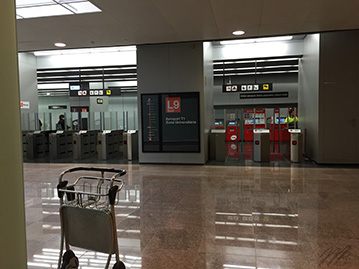
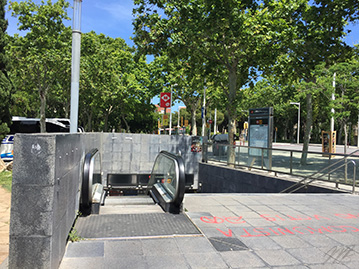
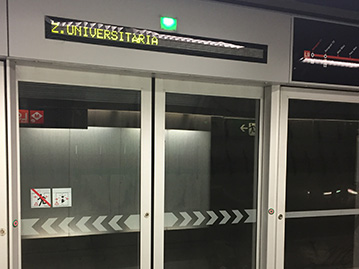
 More than 183 stations and 50 connections, including 2 stops for Barcelona airport T1 and T2 terminals, are distributed among the 12 Barcelona metro lines shared by tmb and fgc public transport networks.
More than 183 stations and 50 connections, including 2 stops for Barcelona airport T1 and T2 terminals, are distributed among the 12 Barcelona metro lines shared by tmb and fgc public transport networks.
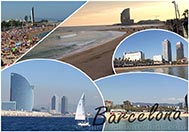 metrodebarcelone.com, your Barcelona travel guide
metrodebarcelone.com, your Barcelona travel guide


